Chuscal shows Tesorito similarities as Los Cerros closes in on porphyry
Hey! Looks like you have stumbled on the section of our website where we have archived articles from our old business model.
In 2019 the original founding team returned to run Next Investors, we changed our business model to only write about stocks we carefully research and are invested in for the long term.
The below articles were written under our previous business model. We have kept these articles online here for your reference.
Our new mission is to build a high performing ASX micro cap investment portfolio and share our research, analysis and investment strategy with our readers.
Click Here to View Latest Articles
Los Cerros Limited (ASX:LCL) has updated the market regarding recently received assays and additional porphyry-focused drilling results from the maiden program completed last year at Chuscal that was aimed at identifying potential porphyry targets.
The Chuscal target is part of the 100% owned Quinchia Gold Project in Colombia which includes the Tesorito near-surface porphyry, and the Miraflores 450,000 ounce Reserve all within a three kilometre radius, plus several undrilled high priority exploration targets.
Drillhole CHDDH10 was the first hole designed to test the eastern or Guyacanes porphyry target established via vectoring information gained from previous drilling.
Of most note, within a broader intercept of magmatic breccias estimated at about 240 metres, was a 75 metre magmatic breccia sub-zone.
This extended from 75 metres downhole with greater density of porphyry vein textures, increased magnetite and elevated gold and porphyry pathfinders, including an intercept of 38 metres at 1.14 g/t gold from 82 metres within 94 metres at 0.63 g/t gold and 20 parts per million molybdenum from 82 metres.
This drillhole is the most westerly on the following diagram.

The aforementioned intercept and other evidence extracted from spatial relationships of lithologies, particularly breccias, was the basis for commissioning CHDDH11 from the same drill pad as CHDDH10, but oriented to the north-west.
This intercepted fine-grained diorite dykes, being a new unit interpreted to be part of the target porphyry suite with elevated porphyry pathfinders.
Vectoring information from CHDDH10 and CHDDH11 were inputs into the location of CHDDH12, located further south of CHDDH10 and collared at a lower elevation.
Based on visual logs (assays pending), CHDDH12 has intercepted the same mineralised fine-grained diorite intersected in CHDDH11 and intruded within that pulse is a 54 metre wide zone of an additional intrusion of porphyritic diorite from 89 metres downhole.
This unit has not been previously logged and displays chlorite-sericite alteration overprinting weak potassic alteration - fine-grained diorite mineralisation that appears to be evident in CHDDH12 is shown below.

Mineralisation to the east could mean the porphyry target is getting closer
One of the key takeaways from recent drilling results is the delineation of gold mineralisation potential at depth where there lies a 164 metre wide zone of magmatic breccia from 211 metres with classic porphyry pathfinder characteristics.
This is the first occasion that diorite, interpreted to be part of the target causative porphyry intrusive suite, has been logged within the eastern target zone, which together with the characteristics of the 164 metre breccia zone, suggests to management that it is closing in on the porphyry target.
The next drill hole (CHDDH13) will step 150 metres further south from pad CHDDH12 and, given the drop in pad elevation, will drill some 200 metres below the aforementioned intersections to test for the presence of an underlying causative gold porphyry.

Discussing these encouraging results and their implications based on the company’s knowledge of surrounding geological features, Los Cerros managing director Jason Stirbinskis said, “This is a highly encouraging development. Through an iterative approach we believe we are narrowing the area in which we expect to hit the eastern Guyacanes causative porphyry.
"In-fact, pending receipt of assays from CHDDH12, we might have already hit the porphyry target in CHDDH12.
"The developing geological model is not dissimilar to the more advanced Tesorito model in which we see distinguishable pulses of different diorites belonging to the porphyry suite with varying degrees of mineralisation.”
Drillhole intersects high-grade epithermal veins as well as porphyry system
The objectives of drill hole CHDDH09 included testing the depth potential of the near-surface Corporacion epithermal vein corridor previously exploited by artisanal miners.
However, Los Cerros was also attempting to gather critical data to support the presence of a western causative porphyry intrusion accountable for local surface gold and molybdenum anomalism.
With regard to the first objective, as indicated below, the hole crossed numerous epithermal veins overprinting the Corporacion Diorite including 1.35 metres at 10.6 g/t gold and 89.8 g/t silver from 133 metres, as well as 2.1 metres at 38 g/t gold and 18.6 g/t silver from 232 metres.

The shallow drilling program continues to discover numerous epithermal veins across the entire Chuscal area, reporting narrow high-grade gold and silver intersections of up to 98 g/t and 90 g/t respectively.
The economic potential of these gold-silver veins remains an ongoing investigation as management focuses on the hunt for large scale gold-copper porphyry style mineralisation.
With regard to the second objective, after leaving the Corporacion Diorite at 332 metre, CHDDH09 entered an 18.3 metre dyke of porphyritic diorite which is interpreted to be the upper portion of the western porphyry target with classic porphyry alteration and A-type veining.
The porphyritic diorite is followed by 75 metres of associated magmatic breccia which comprised a dioritic matrix containing clasts or fragments of porphyritic diorite transported from its source.
It is around this zone of diorite and breccia that gold mineralisation and elevated porphyry element pathfinders were encountered, including 98 metres at 0.6 g/t gold, 92 parts per million molybdenum and 402 parts per million copper from 350 metres.
Hole CHDDH09 is the first occasion that porphyritic diorite, interpreted to be part of the causative porphyry intrusive suite, with associated magmatic breccia, has been logged in the western porphyry target.
From 530 metres to 613 metres (end of hole) there was a moderate increase in molybdenum grades in monzonite with weak potassic alteration to levels suggesting this zone is also near to a causative porphyry source.
Commenting on this development Stirbinskis said, “There is clearly a zone of significant interest from 318 metres worthy of follow up defined by porphyritic diorite, magmatic breccias and elevated copper and molybdenum.
"The deeper zone from 530 metres with a range of molybdenum grades that are typically associated with mineralised porphyries could be attributable to the same porphyry source swelling at depth.”
There could be more catalysts on the horizon for Los Cerros as management expects to provide an update on exploration activities at the near-surface Tesorito porphyry which lies two kilometres to the north of Chuscal before the end of the month.
General Information Only
This material has been prepared by StocksDigital. StocksDigital is an authorised representative (CAR 000433913) of 62 Consulting Pty Limited (ABN 88 664 809 303) (AFSL 548573).
This material is general advice only and is not an offer for the purchase or sale of any financial product or service. The material is not intended to provide you with personal financial or tax advice and does not take into account your personal objectives, financial situation or needs. Although we believe that the material is correct, no warranty of accuracy, reliability or completeness is given, except for liability under statute which cannot be excluded. Please note that past performance may not be indicative of future performance and that no guarantee of performance, the return of capital or a particular rate of return is given by 62C, StocksDigital, any of their related body corporates or any other person. To the maximum extent possible, 62C, StocksDigital, their related body corporates or any other person do not accept any liability for any statement in this material.
Conflicts of Interest Notice
S3 and its associated entities may hold investments in companies featured in its articles, including through being paid in the securities of the companies we provide commentary on. We disclose the securities held in relation to a particular company that we provide commentary on. Refer to our Disclosure Policy for information on our self-imposed trading blackouts, hold conditions and de-risking (sell conditions) which seek to mitigate against any potential conflicts of interest.
Publication Notice and Disclaimer
The information contained in this article is current as at the publication date. At the time of publishing, the information contained in this article is based on sources which are available in the public domain that we consider to be reliable, and our own analysis of those sources. The views of the author may not reflect the views of the AFSL holder. Any decision by you to purchase securities in the companies featured in this article should be done so after you have sought your own independent professional advice regarding this information and made your own inquiries as to the validity of any information in this article.
Any forward-looking statements contained in this article are not guarantees or predictions of future performance, and involve known and unknown risks, uncertainties and other factors, many of which are beyond our control, and which may cause actual results or performance of companies featured to differ materially from those expressed in the statements contained in this article. S3 cannot and does not give any assurance that the results or performance expressed or implied by any forward-looking statements contained in this article will actually occur and readers are cautioned not to put undue reliance on forward-looking statements.
This article may include references to our past investing performance. Past performance is not a reliable indicator of our future investing performance.

